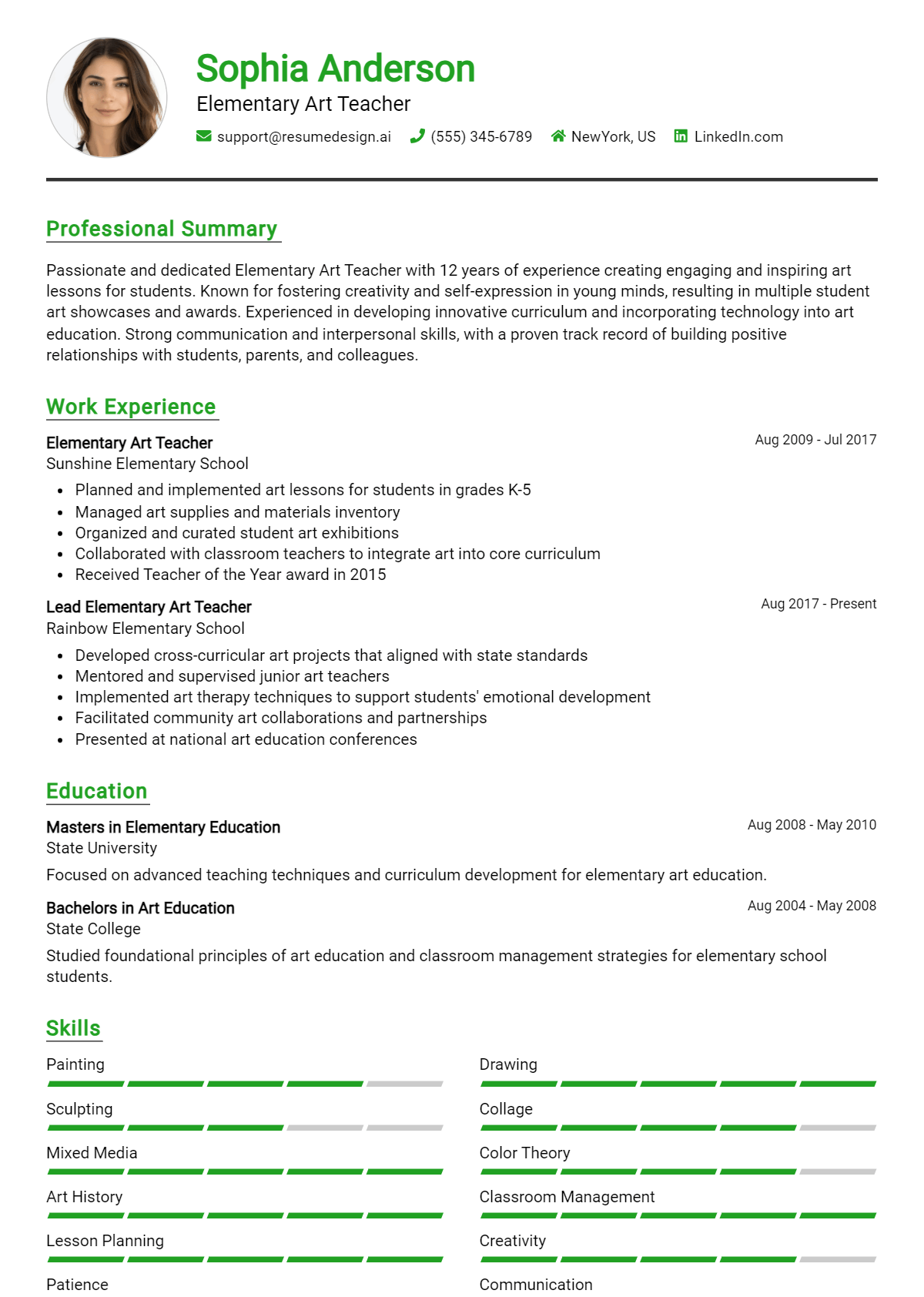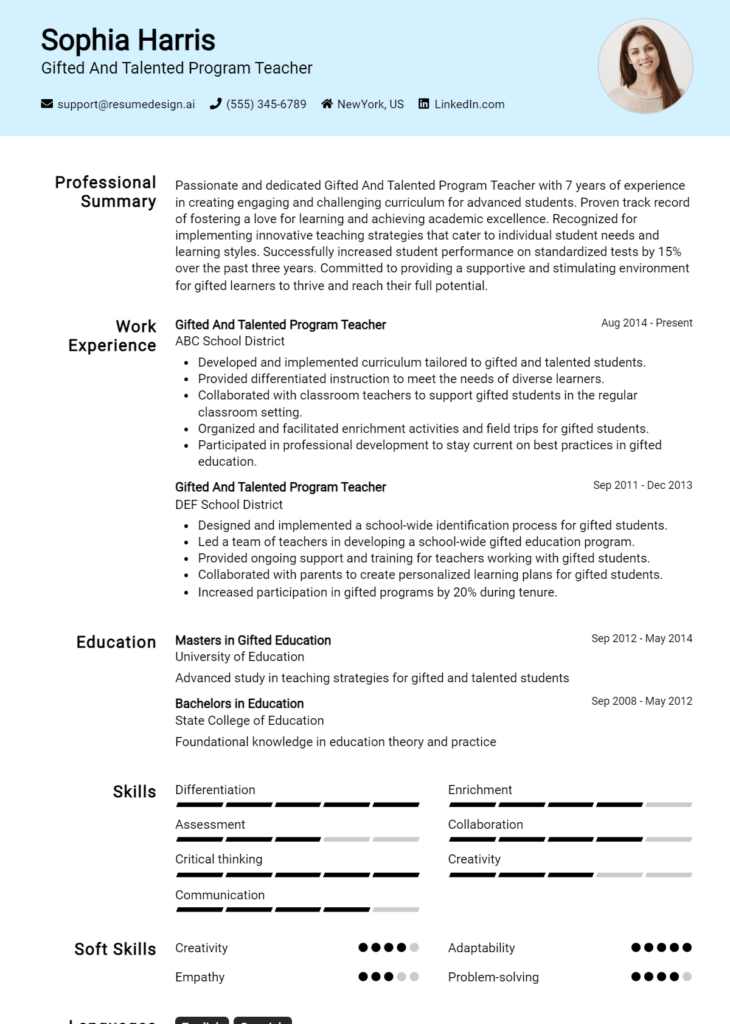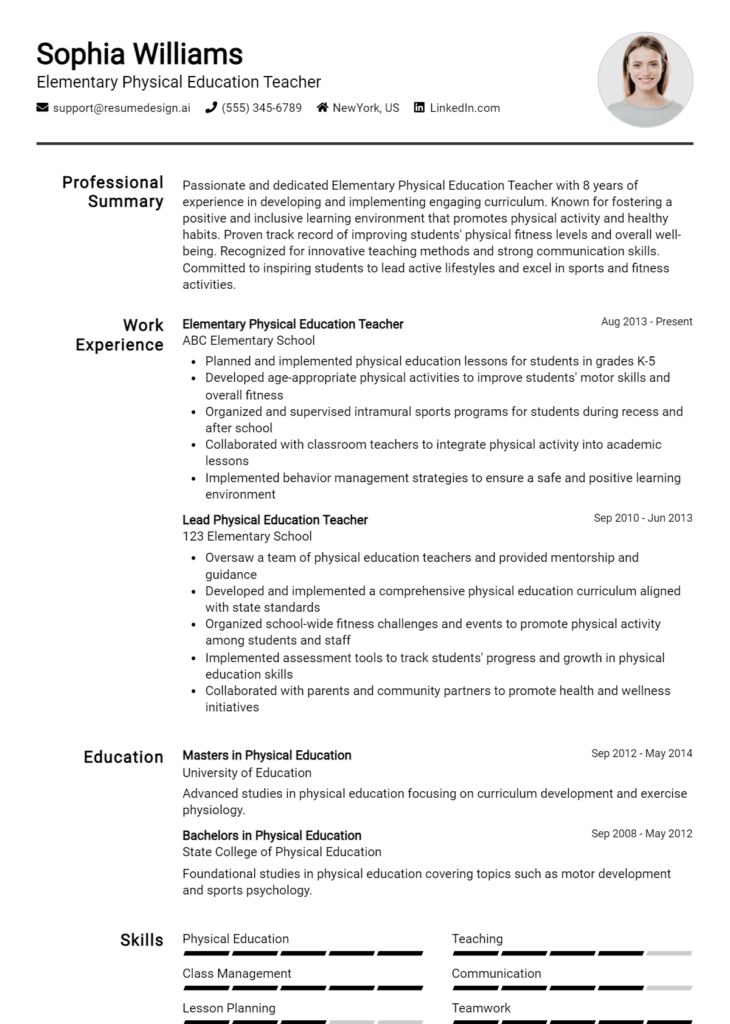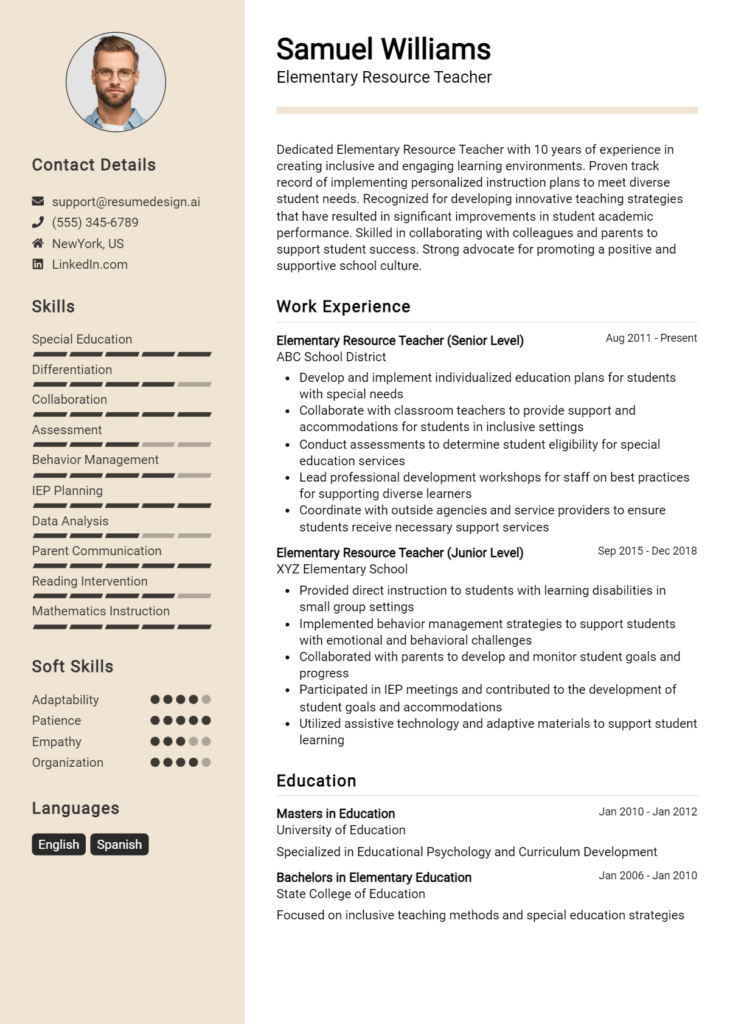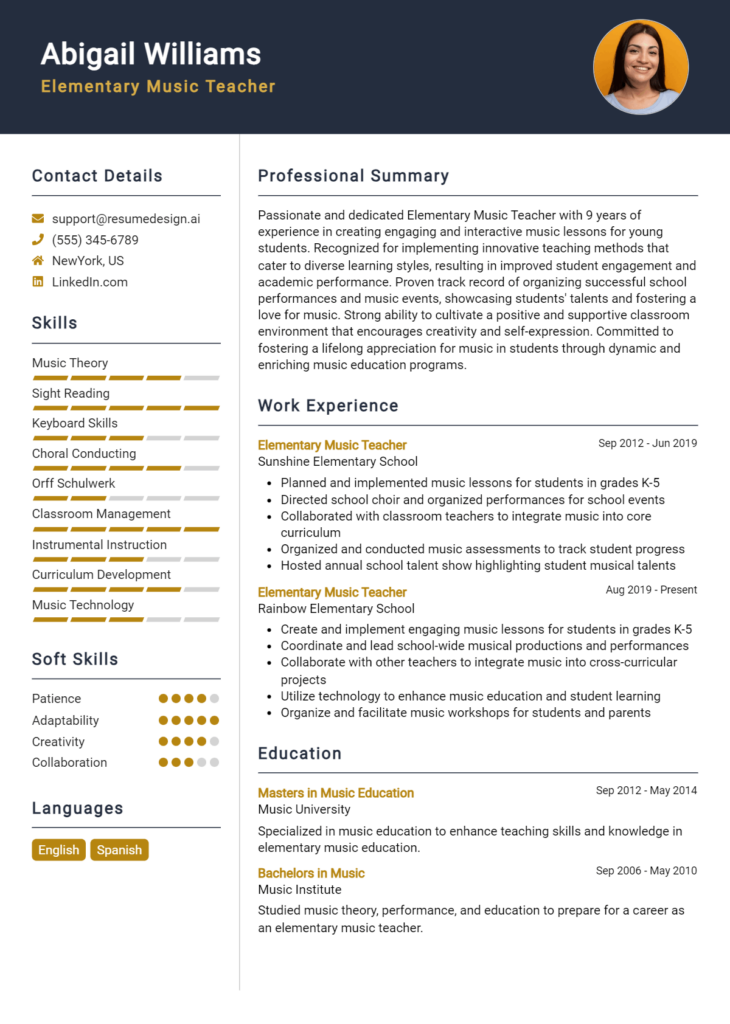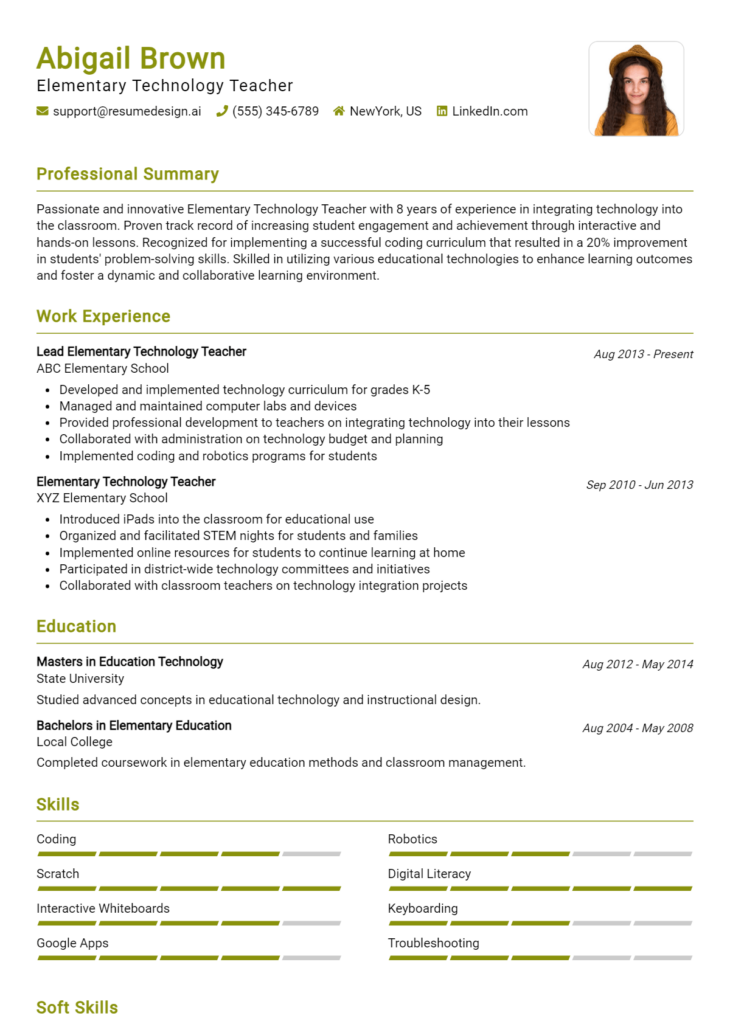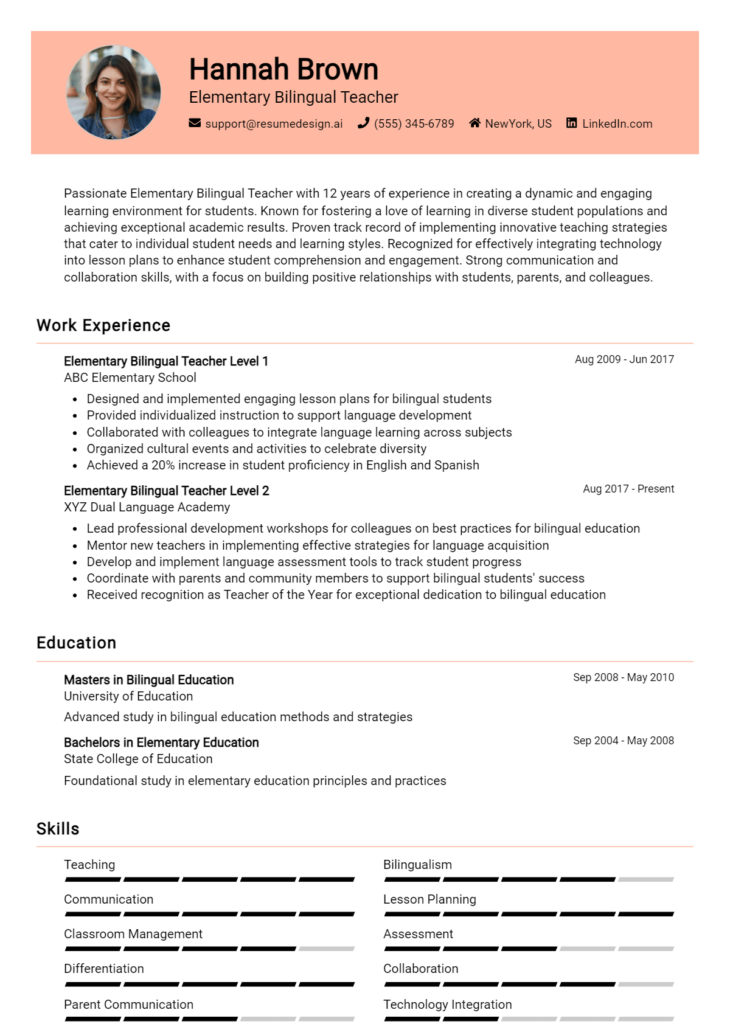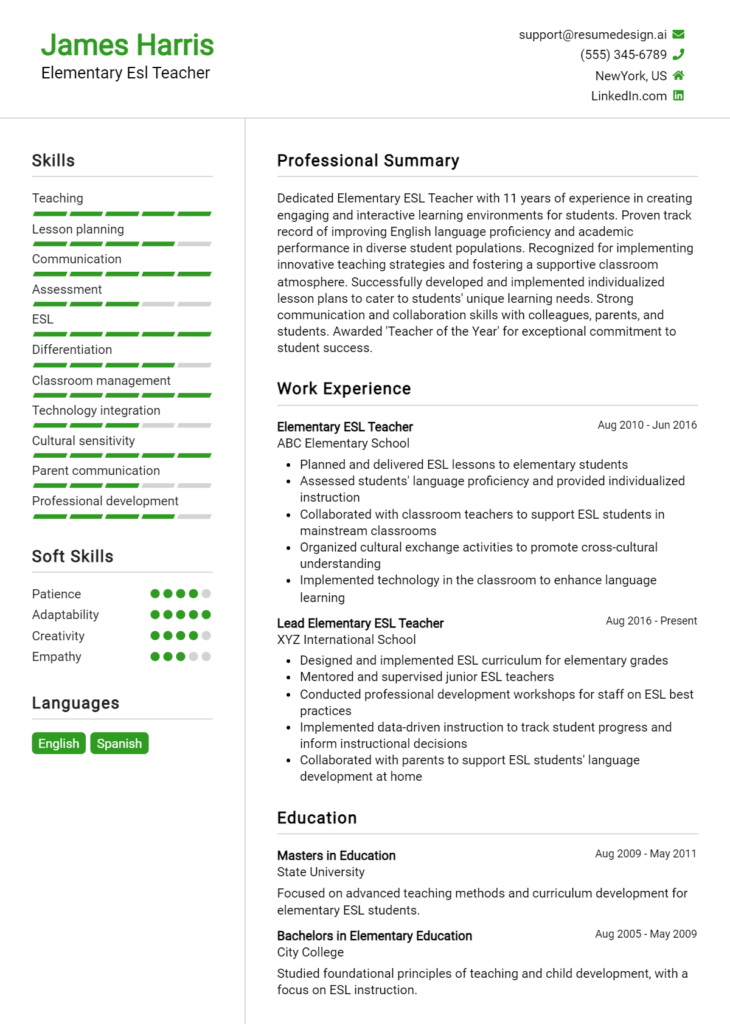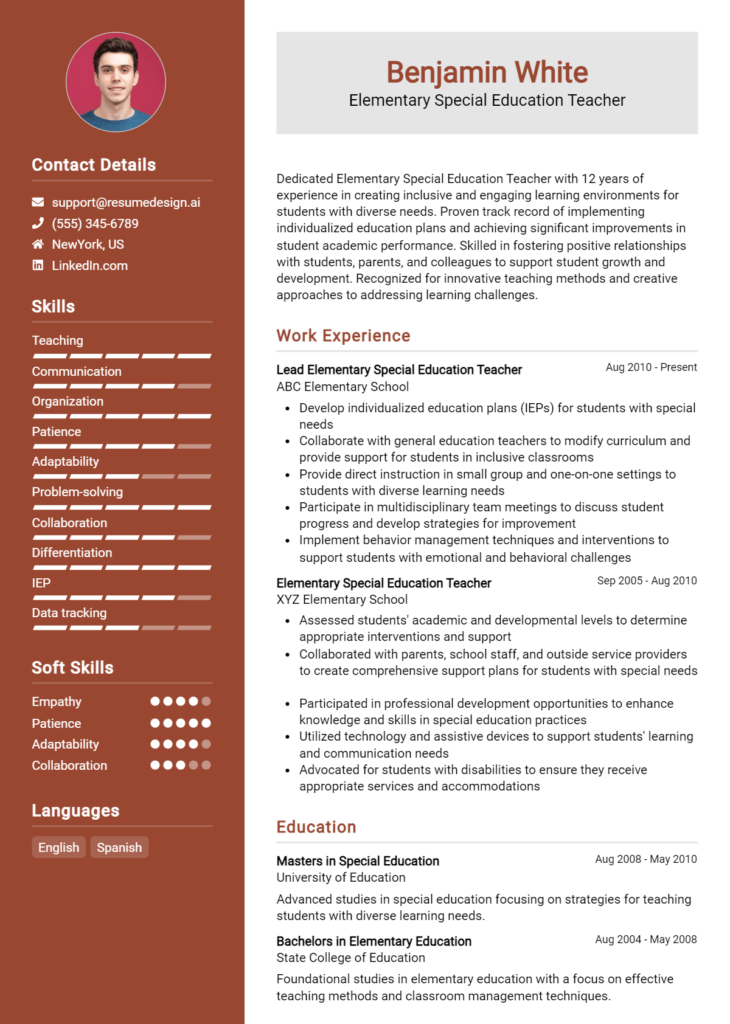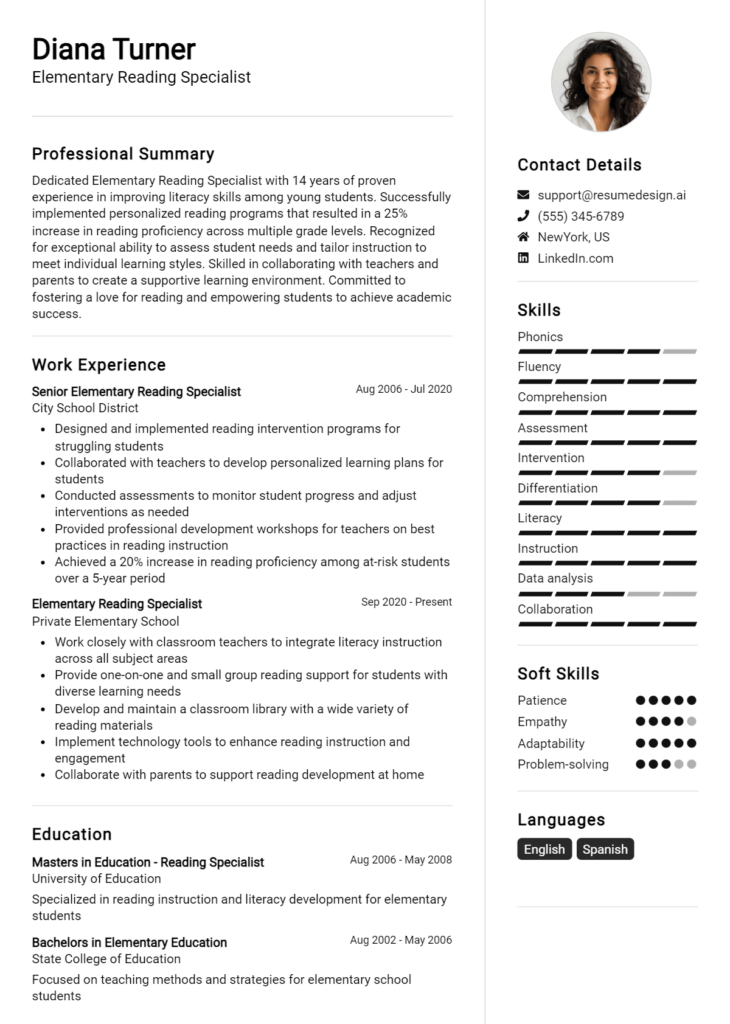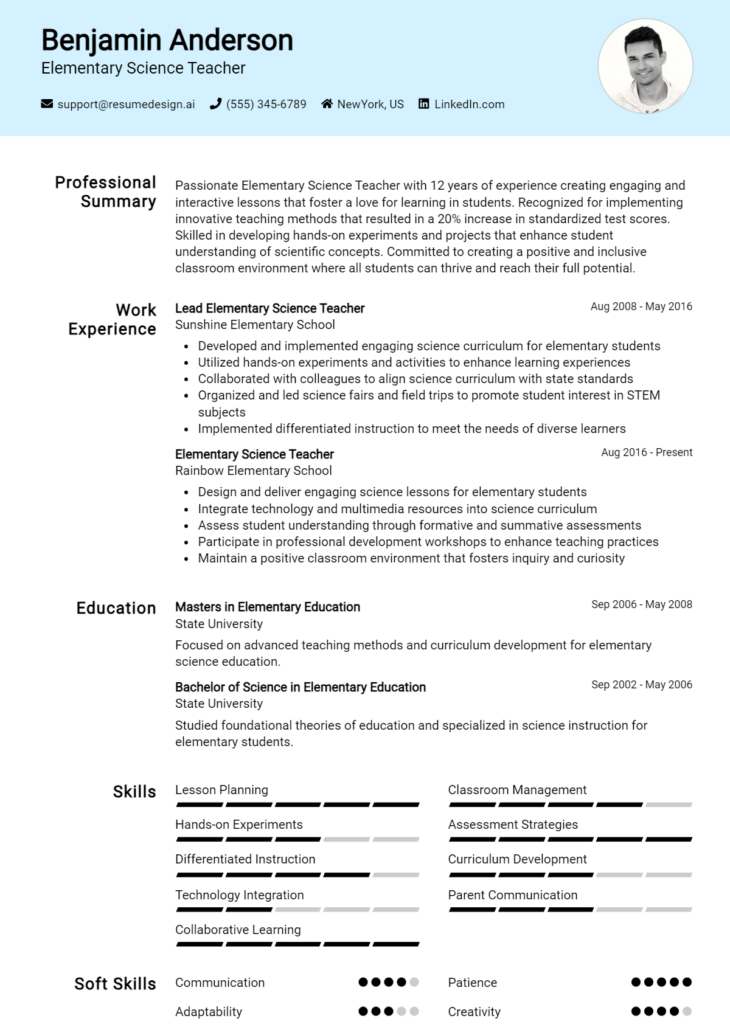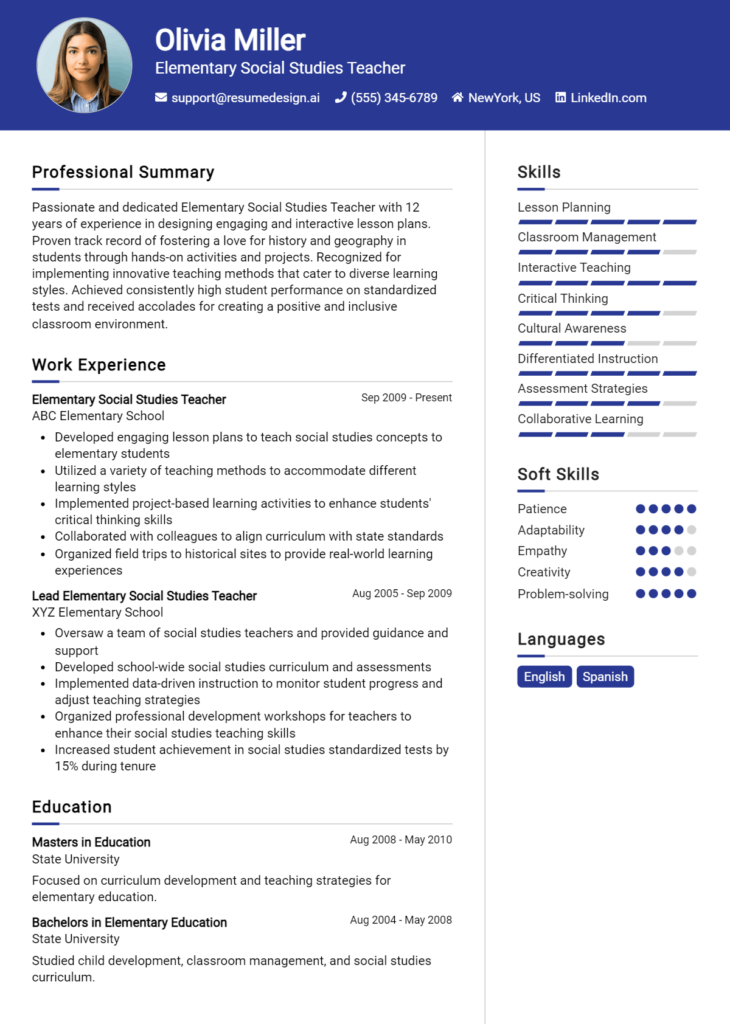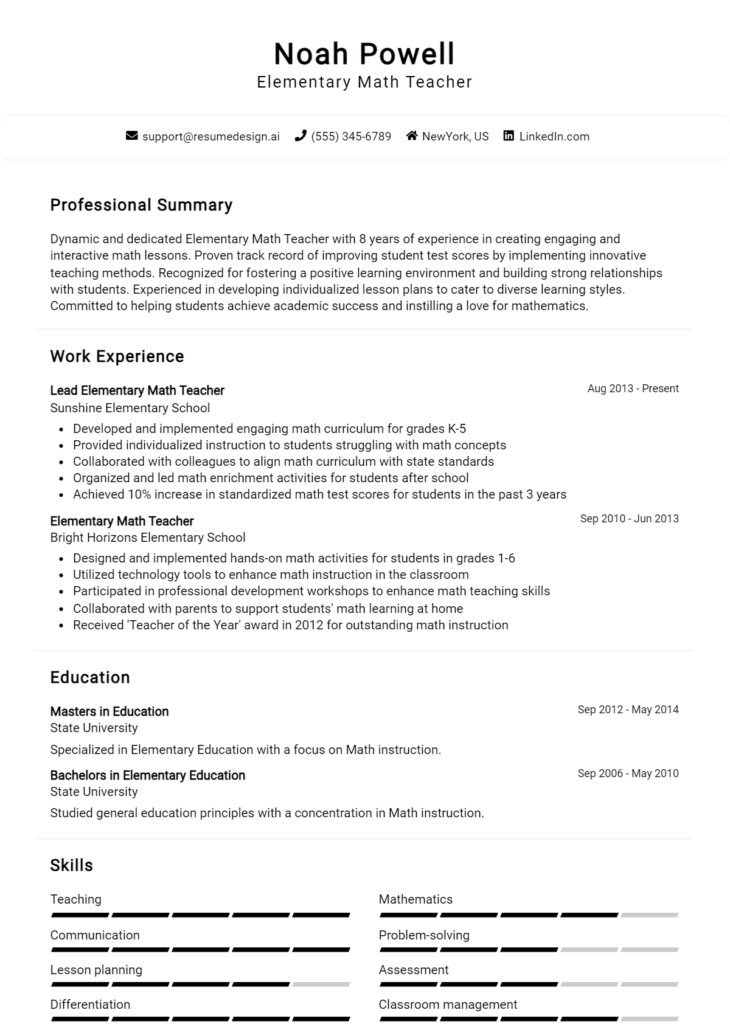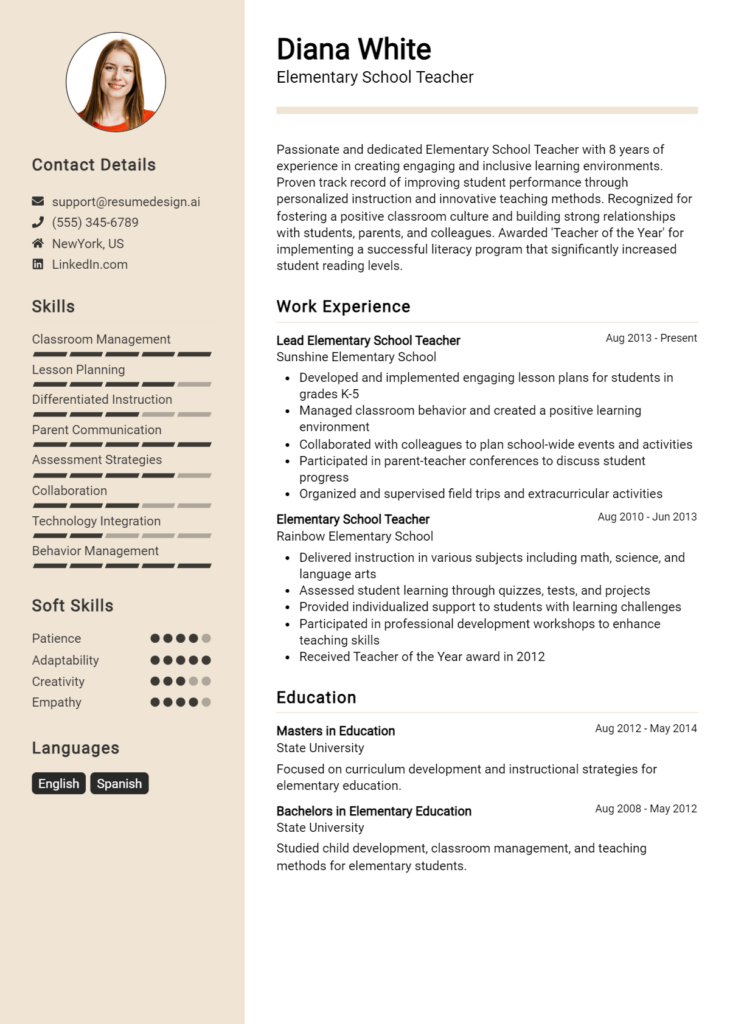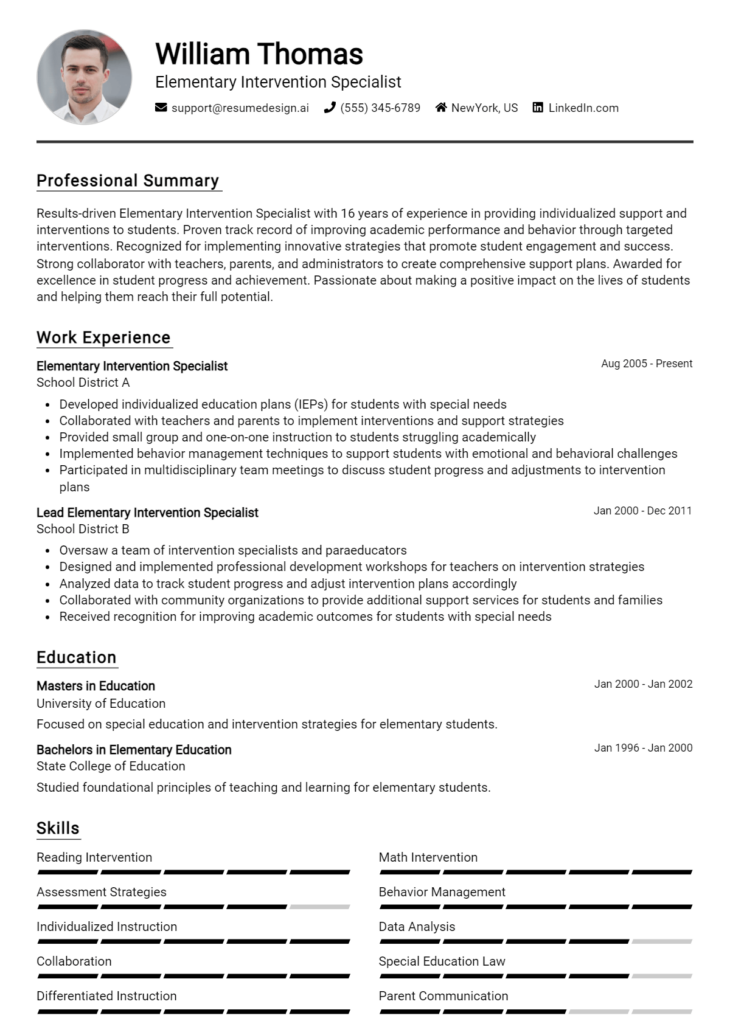Elementary Art Teacher Core Responsibilities
An Elementary Art Teacher plays a crucial role in fostering creativity and artistic expression among young students. Key responsibilities include developing engaging lesson plans, integrating art with other subjects, and assessing student progress. Strong technical skills in various art mediums, operational abilities in classroom management, and problem-solving skills are essential for overcoming challenges that arise during instruction. These competencies contribute significantly to the educational goals of the institution. A well-structured resume can effectively highlight these qualifications, showcasing a teacher's ability to inspire and educate.
Common Responsibilities Listed on Elementary Art Teacher Resume
- Design and implement age-appropriate art curriculum.
- Facilitate hands-on art activities and projects.
- Assess and evaluate student artwork and progress.
- Incorporate art history and appreciation into lessons.
- Maintain an organized and safe art classroom environment.
- Collaborate with other teachers to integrate art across the curriculum.
- Communicate with parents regarding student development and events.
- Organize art exhibitions and showcase student work.
- Stay updated on current art education trends and techniques.
- Encourage creativity and critical thinking in students.
- Manage art supplies and budget effectively.
High-Level Resume Tips for Elementary Art Teacher Professionals
In the competitive field of education, a well-crafted resume is essential for Elementary Art Teacher professionals to stand out. Your resume is often the first impression you make on a potential employer, serving as a window into your skills, achievements, and passion for teaching art. It needs to effectively reflect your unique qualifications and experiences, as hiring committees look for evidence of your ability to inspire creativity in young students. This guide will provide practical and actionable resume tips specifically tailored for Elementary Art Teacher professionals, helping you create a document that showcases your strengths and sets you apart from other candidates.
Top Resume Tips for Elementary Art Teacher Professionals
- Tailor your resume to the specific job description, emphasizing the skills and experiences that align with the role.
- Highlight relevant teaching experience, including specific art classes or projects you've led, and the age groups you have taught.
- Quantify your achievements, such as the number of students you’ve instructed, art shows organized, or improvements in student engagement.
- Incorporate industry-specific keywords from the job listing to pass through applicant tracking systems.
- Showcase your creativity by including a well-designed resume layout that reflects your artistic abilities.
- Include certifications relevant to art education, such as state teaching credentials or specialized art training.
- Demonstrate your collaborative skills by mentioning any teamwork experiences with fellow teachers or community projects.
- List technology skills relevant to art teaching, such as proficiency with digital art tools or online teaching platforms.
- Provide a section for professional development, mentioning workshops or courses that enhance your teaching practice.
- Include a portfolio link or mention an attachment that showcases your students’ artwork or your own artistic endeavors.
By implementing these tips, you can significantly increase your chances of landing a job in the Elementary Art Teacher field. A thoughtfully prepared resume that highlights your unique qualifications and experiences will attract the attention of hiring committees, demonstrating your commitment to fostering creativity in young minds and your readiness to make a positive impact in the classroom.
Why Resume Headlines & Titles are Important for Elementary Art Teacher
In the competitive landscape of education, particularly in the arts, a well-crafted resume headline or title is crucial for an Elementary Art Teacher. This brief yet powerful phrase serves as the first impression a hiring manager will have of a candidate, encapsulating their qualifications and unique strengths in a concise manner. A strong headline can immediately grab attention and highlight a candidate's suitability for the role, making it essential for job seekers to choose words that resonate with the position they are applying for. By ensuring the headline is relevant and impactful, candidates can effectively set the tone for the rest of their resume, encouraging hiring managers to delve deeper into their qualifications.
Best Practices for Crafting Resume Headlines for Elementary Art Teacher
- Keep it concise—aim for one impactful phrase.
- Focus on role-specific keywords that align with the job description.
- Highlight key strengths or unique skills relevant to art education.
- Use action-oriented language to convey enthusiasm and expertise.
- Avoid generic terms; tailor the headline to stand out.
- Incorporate relevant certifications or qualifications when possible.
- Reflect your teaching philosophy or approach in a creative way.
- Be mindful of the tone; it should reflect professionalism and passion for teaching.
Example Resume Headlines for Elementary Art Teacher
Strong Resume Headlines
Innovative Elementary Art Teacher with 10+ Years of Experience Inspiring Young Artists
Passionate Educator Committed to Fostering Creativity and Confidence in Elementary Students
Dynamic Art Teacher Specializing in Integrating Technology into the Classroom Environment
Award-Winning Elementary Art Instructor Focused on Developing Artistic Skills and Appreciation
Weak Resume Headlines
Teacher Looking for Opportunities
Art Teacher at a School
Experienced Educator
The strong headlines stand out because they are specific, convey enthusiasm, and showcase the candidate's unique strengths, making them memorable to hiring managers. In contrast, the weak headlines lack detail and do not provide any insight into the candidate's qualifications or teaching philosophy, rendering them forgettable and less impactful. A well-crafted headline is the key to making a lasting first impression.
Writing an Exceptional Elementary Art Teacher Resume Summary
A resume summary is a crucial component for an Elementary Art Teacher's resume, as it serves as the candidate's first impression on hiring managers. A strong summary quickly captures attention by showcasing key skills, relevant experience, and notable accomplishments that align with the job role. It should be concise yet impactful, providing a snapshot of the candidate's qualifications while being tailored specifically to the position they are applying for. This focused approach ensures that the resume stands out in a competitive job market.
Best Practices for Writing a Elementary Art Teacher Resume Summary
- Quantify Achievements: Use specific numbers or outcomes to highlight your impact, such as the number of students taught or projects completed.
- Focus on Skills: Emphasize skills that are directly relevant to the position, such as curriculum development, classroom management, and creative techniques.
- Tailor the Summary: Customize your summary for each job application by including keywords and phrases from the job description.
- Keep it Concise: Aim for 2-4 sentences that clearly communicate your qualifications without unnecessary fluff.
- Showcase Passion: Convey your enthusiasm for teaching and art, as this can resonate well with hiring managers.
- Highlight Relevant Experience: Mention previous teaching roles, volunteer work, or any relevant workshops that enhance your candidacy.
- Use Action Verbs: Start sentences with powerful action verbs to create a dynamic and engaging narrative.
Example Elementary Art Teacher Resume Summaries
Strong Resume Summaries
Dedicated Elementary Art Teacher with over 8 years of experience fostering creativity and self-expression in students. Successfully developed and implemented a new art curriculum that increased student engagement by 30% over two academic years.
Passionate educator skilled in integrating technology into art education, resulting in a 25% improvement in students' art project scores. Experienced in leading collaborative projects that promote teamwork and artistic skills among diverse classrooms.
Creative Art Teacher with a proven track record of organizing community art exhibitions, showcasing over 100 student artworks annually, and enhancing community involvement in school programs.
Weak Resume Summaries
I am an art teacher who loves working with kids and teaching them about art.
Experienced teacher looking for a new opportunity to teach art in schools.
The examples of strong resume summaries are considered effective because they include specific achievements, quantifiable outcomes, and relevant skills that align directly with the role of an Elementary Art Teacher. They demonstrate the candidate's impact and enthusiasm, making them memorable to hiring managers. In contrast, the weak resume summaries lack specificity, detail, and quantifiable results, making them too generic and less compelling in a competitive job market.
Work Experience Section for Elementary Art Teacher Resume
The work experience section of an Elementary Art Teacher resume is crucial as it provides a comprehensive overview of a candidate's practical skills and achievements in the field of education. This section not only highlights technical abilities in art instruction and curriculum development but also illustrates the candidate's capacity to manage classroom dynamics and foster a collaborative learning environment. By quantifying achievements, such as improved student engagement or successful art exhibitions, and aligning experiences with industry standards, candidates can effectively demonstrate their value to potential employers and their commitment to delivering high-quality educational experiences.
Best Practices for Elementary Art Teacher Work Experience
- Highlight specific art techniques and mediums taught, showcasing technical expertise.
- Include measurable outcomes, such as student participation rates in art programs or exhibition successes.
- Emphasize collaboration with other educators and community organizations to enhance art education.
- Detail any leadership roles in managing art projects or school-wide initiatives.
- Use action verbs to describe responsibilities and achievements for a dynamic presentation.
- Align experiences with current educational standards and art curriculum frameworks.
- Incorporate feedback or testimonials from parents and students to provide qualitative insights.
- Demonstrate adaptability by mentioning any innovative teaching methods or tools utilized.
Example Work Experiences for Elementary Art Teacher
Strong Experiences
- Developed and implemented a comprehensive art curriculum that increased student participation in art classes by 40% over two years.
- Organized and led a school-wide art exhibition, resulting in a 25% increase in community involvement and raising $1,500 for local art programs.
- Collaborated with a team of educators to integrate art into the STEM curriculum, enhancing interdisciplinary learning and improving student engagement scores by 30%.
- Facilitated after-school art clubs, fostering student creativity and increasing attendance by 50% within one semester.
Weak Experiences
- Taught various art lessons and helped students with projects.
- Participated in school events that included art activities.
- Responsible for classroom management during art classes.
- Assisted in organizing art supplies and materials for students.
The examples of strong experiences are considered effective because they provide measurable outcomes, demonstrate leadership, and highlight successful collaboration, all of which are essential for an Elementary Art Teacher role. Conversely, the weak experiences lack specific details and quantifiable results, making them less impactful and memorable to potential employers. Strong experiences clearly communicate the candidate's ability to drive results and enhance the educational experience, while weak experiences fail to convey a meaningful contribution to the art program or the students' learning journey.
Education and Certifications Section for Elementary Art Teacher Resume
The education and certifications section of an Elementary Art Teacher resume is crucial in demonstrating the candidate's academic foundation, specialized training, and commitment to continuous professional development. This section not only showcases the degrees earned and relevant coursework completed but also highlights industry-recognized certifications that validate the candidate's expertise in art education. By providing details on specialized training, candidates can greatly enhance their credibility and align themselves more closely with the requirements of the job role, showcasing their readiness to foster creativity and artistic skills in young learners.
Best Practices for Elementary Art Teacher Education and Certifications
- Include relevant degrees such as a Bachelor’s or Master’s in Art Education or Fine Arts.
- Highlight industry-recognized certifications, such as National Board Certification in Art Education.
- Detail relevant coursework that pertains to child development, teaching methods, or art history.
- Showcase any specialized training in diverse artistic techniques or educational technology.
- List any professional development workshops or conferences attended related to art education.
- Ensure all credentials are up to date and relevant to the teaching position being applied for.
- Use clear and specific language to describe each qualification, avoiding vague descriptions.
- Prioritize recent and advanced credentials to demonstrate ongoing commitment to professional growth.
Example Education and Certifications for Elementary Art Teacher
Strong Examples
- Bachelor of Fine Arts in Art Education, University of Arts, 2020
- National Board Certification in Art Education, 2021
- Coursework: Child Psychology, Art Techniques for Educators, and Curriculum Development
- Certified in Art Therapy Techniques, 2022
Weak Examples
- Associate Degree in General Studies, 2015
- Certification in Graphic Design (not relevant to teaching art)
- Outdated certification in Traditional Painting Techniques, 2010
- High School Diploma with no further education in arts or teaching
The examples classified as strong are directly relevant to the role of an Elementary Art Teacher and demonstrate both academic and professional achievements that align with the job requirements. They highlight recent qualifications, specialized training, and coursework that enhance the candidate's teaching effectiveness. Conversely, the weak examples are considered less relevant as they either do not pertain to art education specifically, are outdated, or lack depth in terms of teaching qualifications. These examples do not effectively support the candidate's capabilities to fulfill the expectations of the teaching position.
Top Skills & Keywords for Elementary Art Teacher Resume
In crafting a compelling resume for an Elementary Art Teacher position, highlighting relevant skills is crucial. Skills not only demonstrate a candidate's qualifications but also reflect their ability to foster creativity and engagement in young learners. A well-rounded skill set can distinguish a candidate in a competitive job market, showcasing their potential to inspire and educate through art. By incorporating both soft and hard skills, a resume can effectively convey the candidate's teaching philosophy, classroom management style, and artistic expertise, making a strong case for their suitability for the role.
Top Hard & Soft Skills for Elementary Art Teacher
Soft Skills
- Creativity: Ability to develop innovative lesson plans that engage students.
- Communication: Effective verbal and written communication with students, parents, and colleagues.
- Patience: Essential for working with young children and managing diverse learning paces.
- Empathy: Understanding and addressing the emotional needs of students.
- Adaptability: Flexibility in modifying lessons based on classroom dynamics or student needs.
- Collaboration: Working effectively with other teachers and staff to enhance the educational experience.
- Encouragement: Fostering a positive environment that motivates students to explore their artistic abilities.
- Problem-Solving: Addressing challenges creatively, whether in lesson execution or student behavior.
- Organization: Maintaining an orderly classroom and keeping track of student projects and supplies.
- Cultural Awareness: Respecting and incorporating diverse artistic traditions into the curriculum.
Hard Skills
- Art Techniques: Proficiency in various art mediums, including painting, drawing, and sculpture.
- Curriculum Development: Designing age-appropriate art curricula that meet educational standards.
- Classroom Management: Implementing strategies to maintain a productive and respectful classroom environment.
- Digital Literacy: Using digital tools and software for creating and teaching art.
- Art History Knowledge: Understanding and teaching the historical context of different art movements and styles.
- Assessment and Evaluation: Developing criteria for assessing student progress and providing constructive feedback.
- Safety Procedures: Knowledge of safety protocols related to art materials and tools.
- Event Planning: Organizing art shows or exhibitions to showcase student work.
- Technology Integration: Utilizing technology to enhance art instruction and student engagement.
- Professional Development: Commitment to ongoing learning in art education practices and techniques.
By showcasing these skills on your resume, along with relevant work experience, you can present yourself as a well-qualified candidate ready to inspire the next generation of artists.
Stand Out with a Winning Elementary Art Teacher Cover Letter
Dear [Hiring Manager's Name],
I am excited to apply for the Elementary Art Teacher position at [School Name] as advertised on [where you found the job listing]. With a Bachelor’s degree in Fine Arts and five years of experience teaching art to elementary students, I am passionate about fostering creativity and self-expression in young learners. My commitment to creating a vibrant and inclusive classroom environment aligns perfectly with the values of [School Name], and I am eager to contribute my skills to inspire the next generation of artists.
In my previous role at [Previous School Name], I developed and implemented engaging art curricula that catered to diverse learning styles and abilities. I believe that art education plays a crucial role in a child’s overall development, and I strive to make my lessons not only educational but also fun and engaging. By incorporating various mediums and techniques, I encourage students to explore their creativity and develop their artistic voice. Additionally, I have organized art shows and community projects that have allowed students to showcase their work and take pride in their accomplishments.
I am particularly drawn to the emphasis on collaboration and creativity at [School Name]. I believe that art should be a collaborative experience, and I am excited about the opportunity to work alongside other educators to integrate art into the broader curriculum. My goal is to create a supportive environment where students feel safe to take risks and express themselves freely. I am confident that my enthusiasm for art and education will positively impact your students and contribute to a dynamic learning environment.
Thank you for considering my application. I look forward to the opportunity to discuss how my background, skills, and enthusiasms align with the vision of [School Name]. I am eager to bring my experience and passion for art education to your team and help cultivate a love for creativity in your students.
Sincerely,
[Your Name]
[Your Contact Information]
[Your LinkedIn Profile or Portfolio Link, if applicable]
Common Mistakes to Avoid in a Elementary Art Teacher Resume
When crafting a resume for the role of an Elementary Art Teacher, it is crucial to present your skills, experiences, and passion for art education in a clear and compelling manner. However, many candidates make common mistakes that can hinder their chances of landing an interview. Avoiding these pitfalls will help ensure that your resume effectively showcases your qualifications and dedication to nurturing young artists.
Neglecting to Tailor the Resume: Failing to customize your resume for each job application can make it seem generic. Highlight experiences and skills that align with the specific school or program’s mission and values.
Overloading with Jargon: Using excessive technical terminology or art jargon can alienate non-artistic hiring managers. Strive for clarity and ensure your language is accessible to a broader audience.
Omitting Relevant Experience: Some candidates forget to include volunteer work, internships, or personal projects that demonstrate artistic skills or teaching experience. Every opportunity counts, especially in education.
Ignoring Format and Layout: A cluttered or unprofessional format can detract from the content of your resume. Use clear headings, bullet points, and a clean design to enhance readability.
Focusing Solely on Teaching Experience: While teaching experience is important, don’t overlook other skills such as classroom management, creativity in lesson planning, and communication abilities that are critical for an art educator.
Forgetting to Mention Professional Development: Not including workshops, courses, or certifications related to art education can make your application less competitive. Continuous learning shows commitment to your professional growth.
Using Passive Language: Phrases like “responsible for” can weaken your impact. Use active verbs such as “developed,” “led,” or “inspired” to convey your contributions more dynamically.
Neglecting to Highlight Technology Skills: In today’s digital age, failing to mention any experience with art-related software or online teaching tools can be a missed opportunity. Showcase your ability to integrate technology into your art curriculum.
Conclusion
As an Elementary Art Teacher, your role is vital in fostering creativity and self-expression among young students. Throughout the article, we explored the essential skills and qualifications needed for this position, including a strong foundation in art techniques, classroom management, and the ability to inspire and engage students in their artistic journeys. Additionally, we discussed the importance of creating a supportive and inclusive environment where every child feels encouraged to explore their creativity.
To ensure that you stand out in the competitive job market, it's crucial to have a well-crafted resume that highlights your unique skills and experiences. Take a moment to review your Elementary Art Teacher Resume and make sure it reflects your passion for teaching and your artistic expertise.
To assist you in this process, consider utilizing helpful resources such as resume templates, which can provide you with a professional layout, or try out a resume builder for a guided experience in crafting your resume. Additionally, exploring resume examples can inspire you with ideas on how to present your qualifications effectively. Don't forget to complement your resume with a captivating cover letter using our cover letter templates.
Embrace the opportunity to showcase your artistic talents and teaching abilities—take action today and refine your resume to make a lasting impression!

